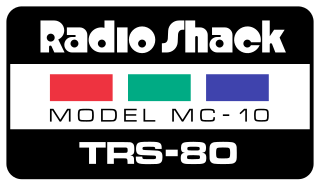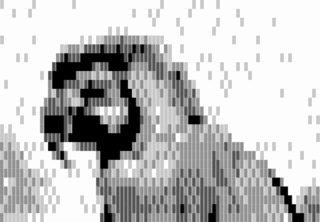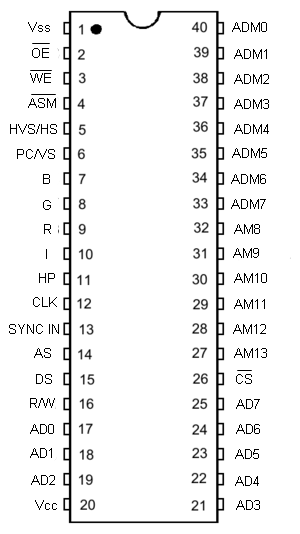
The RadioShack TRS-80 Color Computer, later marketed as the Tandy Color Computer, is a series of home computers developed and sold by Tandy Corporation. Despite sharing a name with the earlier TRS-80, the Color Computer is a completely different system and a radical departure in design based on the Motorola 6809E processor rather than the Zilog Z80 of earlier models.

The Macintosh II is a personal computer designed, manufactured, and sold by Apple Computer from March 1987 to January 1990. Based on the Motorola 68020 32-bit CPU, it is the first Macintosh supporting color graphics. When introduced, a basic system with monitor and 20 MB hard drive cost US$5,498. With a 13-inch color monitor and 8-bit display card the price was around US$7,145. This placed it in competition with workstations from Silicon Graphics, Sun Microsystems, and Hewlett-Packard.

The ThomsonMO5 is a home computer introduced in France in June 1984 to compete against systems such as the ZX Spectrum and Commodore 64. It had a release price of 2390 FF.

The TRS-80 MC-10 microcomputer is a lesser-known member of the TRS-80 line of home computers, produced by Tandy Corporation in the early 1980s and sold through their RadioShack chain of electronics stores. It was a low-cost alternative to Tandy's own TRS-80 Color Computer to compete with entry-level machines such as the VIC-20 and Sinclair ZX81.

The Compukit UK101 microcomputer (1979) is a kit clone of the Ohio Scientific Superboard II single-board computer, with a few enhancements for the UK market - notably replacing the 24×24 screen display with a more useful 48×16 layout working at UK video frequencies. The video output is black and white with 256 semigraphic characters generated by a two kilobyte ROM. It has no bit-mapped graphics capability. The video is output through a UHF modulator, designed to connect to a TV set.

The MC6847 is a Video Display Generator (VDG) first introduced by Motorola in 1978 and used in the TRS-80 Color Computer, Dragon 32/64, Laser 200, TRS-80 MC-10/Matra Alice, NEC PC-6000 series, Acorn Atom, and the APF Imagination Machine, among others. It is a relatively simple display generator intended for NTSC television output: capable of displaying alphanumeric text, semigraphics, and raster graphics contained within a roughly square display matrix 256 pixels wide by 192 lines high.

Micral is a series of microcomputers produced by the French company Réalisation d'Études Électroniques, beginning with the Micral N in early 1973. The Micral N was one of the first commercially available microprocessor-based computer.

The Thomson TO7, also called Thomson 9000 is a home computer introduced by Thomson SA in November 1982, with an original retail price of 3750 FF. By 1983 over 40000 units were produced. About 84 games were released for the TO7.

Text-based semigraphics, pseudographics, or character graphics is a primitive method used in early text mode video hardware to emulate raster graphics without having to implement the logic for such a display mode.

The VG5000μ is a computer created by Philips in 1984. It was manufactured in Le Mans by Radiotechnique (RTS) and marketed under the Philips, Radiola and Schneider brands.

In the 1980s the French Thomson company produced a range of 8-bit computers based on the 6809E CPU.
The Thomson TO16 or Thomson TO16PC is a PC compatible personal computer introduced by French company Thomson SA in 1987, with prices ranging from 9000 to 16000 FF depending on the version.

The EF9345 from SGS-Thomson Microelectronics, Inc., was a semigraphic microprocessor for video image control, encapsulated in a 40-pin DIP and used primarily in the Matra Alice 32, Matra Alice 90 and Philips VG5000 microcomputers.

Toshiba Pasopia is a computer from manufacturer Toshiba, released in 1981 and based around a Zilog Z80 microprocessor. This is not to be confused with the Toshiba Pasopia IQ, a similar named line of MSX compatible computers.
Hector are a series of a microcomputers produced in France in the early 1980s.

SMT Goupil was a French IT company created in 1979 by Claude Perdrillat, previously a senior executive in the General Directorate of Telecommunications.
Léanord was a French computer brand, founded in 1960 at Haubourdin, near Lille. It was a subsidiary of Creusot-Loire and started to develop computers in the late 1970s.

LogAbax was a French computer brand. Founded in 1942, the company was one of France's pioneers in computer manufacturing. The name is composed of two abbreviations: Log from logarithm and Abax from abacus.

The Philips VG-8000, released in 1983, was the first Philips MSX computer, although it was not 100% compliant with the standard. It was released in Belgium, Finland, Germany, and Italy.



















